
After COVID vaccines for children aged five to 11 were approved in late 2021, the UK lagged behind the US and many European countries in rolling them out.
Now, children aged five to 11 in the UK who haven’t yet had a COVID vaccine will no longer be able to get vaccinated, unless they have a particular health condition putting them at higher risk. This comes as the primary vaccination offer is withdrawn for all healthy people under 50 on June 30.
So, healthy children aged five to 11 who are not vaccinated – the majority of this age group, given there is only 10% vaccine coverage in England – will face a very long wait to become eligible for a COVID vaccination, as will younger children. A large part of the argument is that vaccination matters much less now that almost all children over five have been infected at least once. But is this the right policy?
In a recent study, my colleagues and I assessed the benefit of vaccinating healthy children in this age group in England, given high levels of previous infection. We modelled the potential benefit of COVID vaccination at different intervals following a previous infection, and with varying future levels of infection in the population.
We found that while vaccinating healthy five- to 11-year-olds does offer some additional protection against hospitalisation, the more significant benefit of widespread vaccination for this age group comes in preventing long COVID.
Infection and hospitalisation
The protection a previous COVID infection confers against serious illness from a new infection is very good. Our modelling showed that in the first six or so months following infection, there’s little benefit to vaccination since protection is still strong. But protection against severe disease does eventually wane over time.
One study estimated that protection against hospitalisation was 99% two months after an infection in unvaccinated children, and 87% ten months later.
Vaccination can boost children back up to virtually 100% protection against hospitalisation. This could avert a significant number of hospitalisations, but only if infection levels are relatively high over the months following vaccination.
For example, assuming an average of a year since previous infection, we estimated that if 25% of healthy children aged five to 11 in England are infected in the six months after all of them are vaccinated, only about 160 hospitalisations might be averted, compared with roughly 500 averted if 75% were infected.
COVID hasn’t gone away and infection rates have remained high since the summer of 2021, with smaller but frequent waves over the past nine months. Vaccinating all healthy children now would probably lead to a modest benefit of a few hundred hospitalisations averted, but this number will also grow the longer it is since the last big wave of infection in children (now around a year).
The picture looks different for long COVID
While most children recover fully from a COVID infection, some develop long COVID. Recent evidence suggests previous infection doesn’t protect children significantly from long COVID on reinfection. However, there’s good evidence that vaccination reduces rates and severity of long COVID, at least in adults.
We estimated that vaccination a year after previous infection could prevent well over 30,000 cases of long COVID in healthy five- to 11-year-olds in England, if 50% were reinfected over six months. However, the exact figure may be somewhat more or less, because there’s not much rigorous evidence on long COVID incidence in children after infection or vaccination.
Even in a very small wave where only 5% of healthy five- to 11-year-olds in England were reinfected over six months, we estimated that vaccination could still prevent a few thousand cases of long COVID. The benefits could be significant. Even if most children with long COVID recover within six months, that’s still a potentially big impact on a child’s life and education.

Younger children
Our study was based on the fact that most children aged five to 11 have been infected at least once. But the riskiest COVID infection is the first one, particularly in unvaccinated people. And there remains one segment of our population that has never been vaccinated and where many are still to face their first infection: children under five.
While effective COVID vaccines for children aged six months to five years exist and are approved around the world (including in the UK), they’ve never been offered in the UK to children with no underlying conditions.
Yet kids under five have COVID hospitalisation rates three times higher than six- to 17-year-olds and half those of 18- to 64-year-olds, with over 22,000 hospitalisations to date in England. Rates of intensive care admission in children under five are higher than any age group until people 45 and over.
For the first six months of life, maternal antibodies persist in the baby, especially with vaccinated mothers. But once these have waned, a UK infant faces a first COVID infection without any protection from vaccination or previous infection.
How could the UK improve its COVID vaccination policy for kids?
For very young children, giving them the protection of vaccination before they have a chance to be infected seems sensible. In the US, for example, COVID vaccination has become part of the routine childhood immunisation programme between six and 12 months of age.
For older children, the longer the time since a previous infection, the more beneficial vaccination becomes – to protect against hospital admission and especially long COVID.
But, while accounting for time since last infection has merit, implementing such a programme would be difficult, since it depends on knowing when most children were last infected. Currently, the virus is determinedly not confined to a single season.
In the absence of age-specific estimates of COVID prevalence over time (which we had in the ONS infection survey until it concluded), the UK could keep the offer of vaccination open to parents but not run concerted campaigns. Parents could be advised to wait at least six months after previous known infection to increase their child’s benefit from the vaccine. But of course, lack of routine testing (particularly in asymptomatic children) makes it harder to know when the last infection occurred.
Another option would be to invest heavily, as the US is doing, in developing COVID vaccines that have much longer-lasting protection, increasing their population benefit.
In short, vaccination policy must be regularly reviewed in the context of who hasn’t been infected, whose protection is likely to be waning, and future likely exposure rates. We do this already for adults but children can also face consequences from COVID, and gain benefits from vaccination.
Christina Pagel is a member of Independent SAGE.
This article was originally published on The Conversation. Read the original article.







